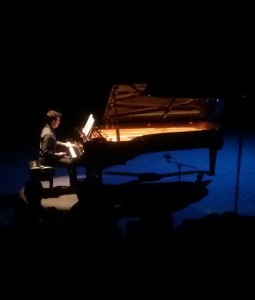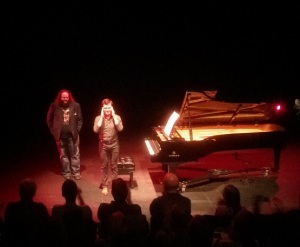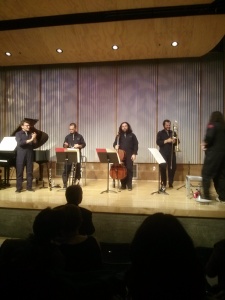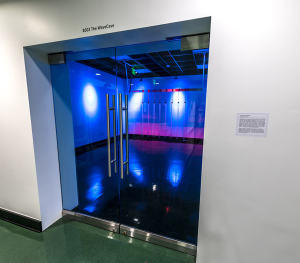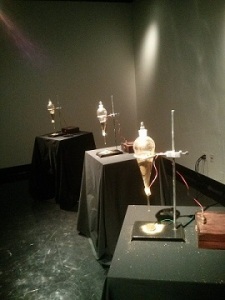Cross-posted from my home site, The Big City, here are my lists for top new music recordings of the year, in a few different categories:
Best 2014 Albums of New Classical Music:
- Dan Becker, Fade. Not just a set of excellent compositions, but a rarity in classical music, a set that is thought-out and made to work as an album. Becker’s music shares some of the hints of pop sensibility with that of Michael Torke, but has a tougher, more abstract edge. Terrific chamber pieces, played b y the Common Sense and New Millenium Ensembles, are interspersed with Diskclavier realizations of Becker’s “Reinventions,” harmonic structures from Bach on which he’s placed his own, improvisatory lines. Listening to the album is an affirmation of the past, of the incredible accumulation of music and ideas, and the possibilities of the future. Deeply enjoyable.
- Martin Bresnick: Prayers Remain Forever. Bresnick has been indispensable as a teacher to the current generation of new composers, and his own music is sublime, with exquisite craft, an ear and heart for the beautiful, and a transparent, graceful and unselfconscious connection to the common musical materials all around us. This is a superb collection of recent chamber works, beautifully played.
- Ralph van Raat: Fred Rzewski: Four Pieces. Rzewski’s political themes, as strong as they are, have overshadowed his achievements as a pure composer. The People United Will Never Be Defeated is a statement, and also one of the great works of variations in the classical literature. If that is his Goldberg, then Four Pieces is his “Hammerklavier,” a tremendous piano sonata in classical form.
- Ludovic Morlot, Seattle Symphony, John Luther Adams: Become Ocean. A welcome Pulitzer Prize winning composition that actually deserves the award, a concentrated culmination of JLA’s strengths as a composer. The recording is also superior to the live performance at Carnegie Hall in May, where the piano part was buried under the orchestral textures.
- Arditti Quartet, Bernhard Lang: The Anatomy of Disaster. Another installment in composer Bernhard Lang’s Monodologies series, and one of several excellent Arditti Quartet albums released this year. This made the list due to my personal affinity for Lang as a composer and a man. Based on Haydn’s The Seven Last Words of Christ, Lang’s writing is bitingly expressive, destabilizing, and a real ethical and moral antidote to the problem of endless, quantized, manufactured loops and repetitions.
- Camerata Pacifica, John Harbison: String Trio, Four Songs of Solitude, Songs America Loves to Sing. I have mostly grudgingly admired Harbison’s composing, appreciating how his music was made without enjoying it, so this set of chamber music and songs was a surprise. The musical language has both greater expression than I’ve heard from him before, and also greater, coherent rigor. He’s pared down his materials and now says more. The Camerata Pacifica plays with natural ease and assurance.
- Jeroen van Veen, Van Veen: Piano Music. Give the pianist some. Van Veen has produced two great, comprehensive sets of minimalist piano music, as well as the ultimate collection of Simeon ten Holt’s Canto Ostinato, so why not gives us this multi-disc box of his own compositions? Not all of the 50 tracks are great, but so much of this music is, especially his Minimal Etudes
- yMusic, Balance Problems. Terrific chamber pieces from composers in and around the orbit of New Amsterdam records; clear, tough-minded post-minimal music, just skip the series of chords at the end, from Sufjan Stevens, that masquerade as a composition.
- George Crumb: Voices from the Heartland, Sun and Shadow. Not fade away. Critical interest seems, oddly, to have turned away from Crumb, as if he is neither productive or relevant. This album proves otherwise, especially in the premiere recording of Voices from the Heartland, which concludes his American Songbook cycle. Crumb is misapprehended as belonging to a particular, dated, intellectual fashion for mysticism, when it is his critics who are lost in the vagaries of the zeitgeist. The beauty and craft of Crumb’s music are timeless.
- Steve Reich: Radio Rewrite. Indispensable as every other new set of pieces from Reich, this is sure to please his pop followers with Jonny Greenwood’s solid playing of Electric Counterpoint and the premiere of his Radio Rewrite, a subtly strong piece that is part of an on-going transitional period. But most impressive is Vicky Chow’s fantastic solo performance of Piano Counterpoint.
- Tyshawn Sorey Trio, Alloy. My personal favorite and overall best record of the year. One reason for that is the musical ideas inside it are so deep and powerful that they’re a little bit frightening, it’s a large universe in which to lose oneself. Alloy is on a lot of jazz lists, but I can’t put it on mine: Sorey is most closely and accurately defined as a jazz musician, but this is an album, like his others, of his compositions, and there is so little jazz concept and aesthetic in them that they are pretty much sui generis. One of the fascinating features of his music is that, while he can be heard at the drum kit, the sense of rhythm as time is almost nonexistent (except in “Template”). The music is full of space, a sense that notes and events are placed intuitively (which I deeply admire, it’s extremely difficult to develop the ear and confidence to write such sparse yet finely structured music), the feeling of an internal journey without beginning or end. Feldman is the heuristic commonly applied to Sorey’s composing, but that’s misleading. Feldman, especially his mature music, wrote scores that are dense with activity. Sorey shares a taste for low dynamics, but the sparseness of his music sounds closer to Cage, only with an entirely different idea of expression. Imagine a Miles Davis trumpet solo removed from a tune, with the space inside expanded by magnitudes, and you get some idea of both the manner of this album, and how great the music is.
- Bora Yoon, Sunken Cathedral. Tremendously beautiful and involving. This is the audio portion of Yoon’s ambitious multimedia project that will appear at the Prototype Festival next month. The sound combines the purity of her voice. chant, electronic textures, folk instruments, spoke word, and more. Another concept that is fiendishly difficult to hold together, and the firmness of her form makes this exceptional.
- Tristan Perich, Surface Image. Perich’s work combines imagination and process: as his pieces go along, or as you see them in an installation, the path connecting conception, process and execution is always clear. That alone is both important and satisfying, but the results, like this mesmerizing, new post-minimal piece for piano and electronics, are great music in their own right.
- a.pe.ri.od.ic, Jürg Frey: More or Less. It’s a good year when I have to choose between this and Andy Lee’s album of Frey piano music, the difference being that I found myself listening to this set of amazing chamber pieces, in excellent performances, a little more often.
- Harry Partch, Harry Partch: Plectra and Percussion Dances. Self-recommending. This is the first complete recording of the title work, and the CD includes a spoken introduction by Partch that he delivered in 1953.
- Peter Söderberg, On the Carpet of Leaves Illuminated by the Moon. Söderberg plays the lute, and on this record he performs music by Alvin Lucier, James Tenney, John Cage and Steve Reich. That’s really all you need to know.
- Flux Quartet, Morton Feldman: String Quartet No. 1. Utter masters of this music. Flux followed up what is now an almost routinely great concert of Feldman’s String Quartet No. 2 with this release. The finest recoding of the String Quartet No. 1, and the finest traversal of the complete string quartet music by Feldman.
- Ursula Oppens, Bruce Brubaker, Meredith Monk: Piano Songs. Not songs, but piano music, with occasional shouts and yelps. Echt-Monk, the physical vitality of her music, the way the pianos sound like they are hopping and dancing, is a tribute to her compositional ideals. A little disorienting at first to hear her style applied to the keyboard, but it gets better with every listen.
- Dai Fujikara, Dai Fujikara: ICE. This is simply one of the finest collections of music at the cutting edge of the classical tradition that I’ve heard in years. Fujikara renders the densest and most complex ideas with complete clarity and control of his materials, and ICE plays the music like they’ve been working on it for years. Which they pretty much have.
- Sarah Cahill, Mamoru Fujieda: Patterns of Plants. Fujieda’s work is one of the most striking compositions in contemporary music. The music is literally organic, composed out of Fujieda’s recordings of electrical activity in plants. What comes out is music that has an uncanny feeling of belonging to every place and epoch, yet having no identifiable national or temporal features. It is truly strange and beautiful. Cahill plays it with the attention to detail and musicality that one usually hears pianists bring to Schubert. Not a complete set of this magnum opus, but the most extensive to date.
- Nils Bultmann, Troubadour Blue. A set of musical rich and beautiful viola improvisations that delve deep into the history of western music.
- Bernd Klug, Cold Commodities. A gripping, surprising, unique and accomplished album that combines found sounds, electronics and improvisation with tremendous rigor and expression.
- Asphalt Orchestra plays the Pixies: Surfer Rosa. An amazing record. These arrangements are imaginative sonic adaptations of the classic Pixie’s album, transforming the originals into something more complex and more consistently satisfying.
- Robin Williamson, Trusting in the Rising Light. A strange, entrancing disc from one of the founders of The Incredible String band. This is a collection of songs that, though originals, have deep roots in ancient memories and traditions. WIlliamson’s voice is ravaged with age, making the expression that much more effective. Fantastic accompaniment from Mat Maneri and Ches Smith.
- Lumen Drones. Post-rock meets Hardanger fiddle. Difficult to describe, the music drone based, full of rhythm and improvisation, tough and delicate at once. Must be heard, it’s completely wonderful.
- Carolina Eyck, Christopher Tarnow, Improvisations for Theremin and Piano. Much more than a curiosity, this is fascinating set. Eyck is a tremendous theremin player, with complete command of tone and texture. Mostly quiet and tonal, the playing is superb, don’t be thrown by the twee track titles.
- Battle Trance, Palace of Wind. I have the privilege of experiencing a performance of this piece by this quartet of tenor saxophonists, and it was jaw-dropping and powerful. Imagine Colin Stetson times four, playing non-stop for about forty five minutes with a romantic conception of transcendence, and you have some idea of the depths of this album.
- Travis Just + Object Collection, No Song. Downtown to the max, turned up to 11! The good natured aggression of this record adds a sense of fun, but the playing is purposeful, intense, and heavier than the doomiest sludge. (http://shop.khalija.com/album/no-song)
- Plymouth. The members of this band are Jamie Saft, Joe Morris, Chris Lightcap, Gerald Cleaver and Mary Halvorson. They play dense, lively, passionate, intelligent noise improvisations. Excellent in every way, and the best release so far from Rarenoise records.
- Thurston Moore/John Moloney, Caught on Tape. Loud, but delicate. The muscularity hides what, underneath, is a severe, even ascetic aesthetic, a search for beauty in the midst of conflict, like the edge of razor blade, shining through a pile of trash. Pretty much Moore’s finest moments as a guitar player.
- Dave Seidel, ~60Hz. As pure as music gets. Seidel’s pieces are made by combing sine waves and letting them play. Engrossing and gorgeous.
- John Supko, Bill Seaman, s_traits. This record is astonishing. I’ll refer you to Marshall Yarbrough’s article for the details, but this upends every idea of structure and form and makes it work. Hard stop listening to.
- No Lands, Negative Space. A prime example of the possibilities of electronic music: this band’s debut (mainly it’s Michael Hammond), is as abstract as Ussachevsky and as appealing as Tangerine Dream. Excellent.
- Guenter Schlienz, Loop Studies. A haunting exploration of looped acoustic instruments and electronics. The music seems to be coming from the type of future that the past imagined would arrive. (https://sinkcds.bandcamp.com/album/loop-studies)
- Philip White, Documents. Plastic, complex sound produced from the raw musical data extracted from a series of well-known, popular recordings. (https://philipwhite.bandcamp.com)
- Michael Pisaro, Continuum Unbound. Field recordings and instrumental music, listening across the three discs is a transporting experience. (http://michaelpisaro.blogspot.com/2014/05/continuum-unbound-fall-2014.html)
- Rand Steiger, A Menacing Plume. Electro-acoustic works with a classical feel of modernism. Steiger is fine composer and the pieces, including the superb title work and Résonateur, are played expertly by Talea Ensemble.
- Jacob Cooper, Silver Threads. There are many projects that combine voice and electronics, but they are rarely as accomplished as this set of electronic art songs, with the terrific Mellissa Hughes singing.
- Juan Bianco, Nuestro Tiempo. Electronic music from Cuba that might have been a mere object of curiosity, but Bianco, who was unknown to me when this arrived, is a serious and excellent composer, with a sense of vitality.
- Faures, Continental Drift. Like atmospheric haze composed of tiny, shiny crystals; pristine, warm, enveloping. (https://homenormal.bandcamp.com/album/continental-drift)

